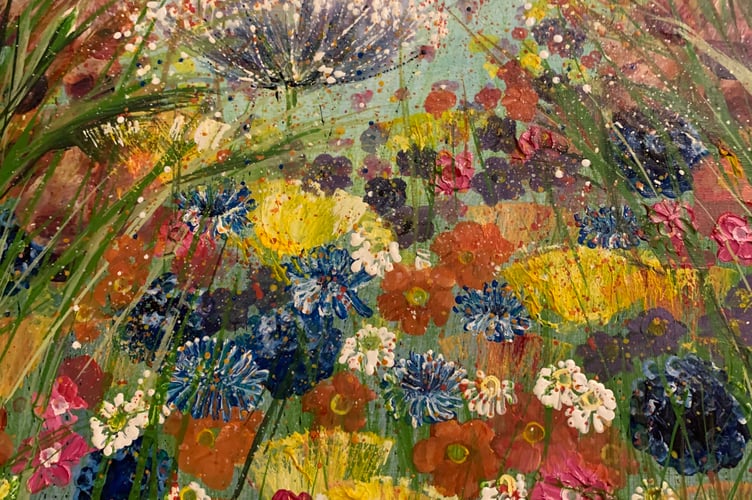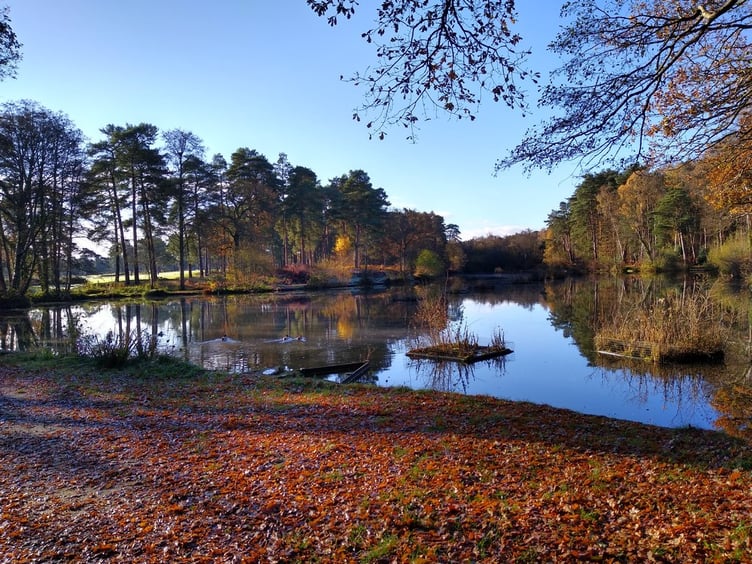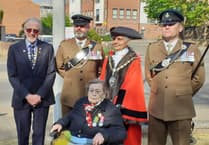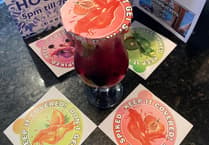Petersfield Ramblers
On November 20, a beautifully sunny but crisp and frosty morning greeted 15 enthusiastic ramblers who gathered at Stockbridge car park in Tilford.
Initially, they took the old Elstead road past Stockbridge Pond, once part of a series of ponds created and used for fishing by the monks of Waverley Abbey. After looking down from some height to the River Wey below, they turned across the more open sandy Surrey Heath terrain which makes up Hankley Common military training area, part of the Thursley, Hankley and Frensham Commons Special Area of Conservation, a Special Protection Area and Site of Special Scientific Interest.
On passing through Lion’s Mouth, they reached the replica Atlantic Wall, built in 1943 by Canadian Troops as a training aid prior to D-Day. A gentle climb to the top of Kettlebury Hill led to a coffee stop, overlooking the dropping zone where paratroopers were trained by jumping both from barrage balloon baskets and aircraft, and with views to the Hogs Back to the north and the Devils Punchbowl to the south.
After walking the length of Kettlebury Hill and pausing at a trig point, the ramblers passed Rushmoor lakes and crossed Tilford Road onto Churt Common. Ascent to the top of the regionally important geological site known as Stony Jump brought a lunch stop, from where they enjoyed the excellent views of priceless heathland habitat including Axe Pond (The Flashes). Stony Jump is one of three hills known collectively as the Devils Jumps, with local folklore telling of the Devil jumping between them. The Norse god Thor apparently became so annoyed at this he threw a boulder at the demon, sending him flying into the Devils Punch Bowl.
Descending to pass Axe Pond, they continued a short way down the quiet Sandy Lane and then across Frensham Common, passing Frensham Little Pond, from where they returned to Tilford through more wooded scenery along the unmade Tilford Common Road.
The Arts’ Society, Farnham
The November lecture was given by James Renshaw, who took a degree in classics from Oxford University and has taught classics at secondary school level since 1998.
He currently teaches at Godolphin and Latymer in London, where he runs the school’s Ancient World Breakfast Club, which has an ethos similar to that of The Arts’ Society. He has also published a number of books related to the classical world and has lectured at the V&A Academy. His subject was ‘Two Hellenistic Cities: Alexandria and Pergamon’.
The audience learned that by 323 BC, Alexander the Great had conquered the Persian empire and launched a new era of Mediterranean history, known today as the Hellenistic Age. The world had changed, and soon two cities emerged as centres of extraordinary culture and learning. In Egypt, Alexandria soon became the intellectual hub of the ancient world, which saw extraordinary discoveries in science and mathematics, philosophy, and medicine. Meanwhile, in north-west Asia Minor, the Attalid kingdom developed a new capital city, Pergamon, as a cultural centre to rival Alexandria.
Alexandria was to have a long history: a multicultural entrepot facing Europe with the huge wealth of Egypt at its back, its lighthouse acting not only to bring ships safely to harbour but also to act as a symbol, a beacon, of academic, intellectual and cultural activity with a library reputed to contain 400,000 volumes.
Pergamon, in comparison, was a small land-locked state, albeit wealthy from its gold, which decided that it would compete with Alexandria, creating a library said to contain 200,000 volumes. This ambition led to Alexandria banning the export of papyrus to Pergamon, which in turn caused Pergamon to use parchment for its volumes; the word parchment is derived from Pergamon.
In both cities, the art was of the everyday not of the imperial or the divine. Whilst Alexandria in later years was never trusted by the Romans (think Cleopatra), Pergamon was an early ally of Rome, as its empire expanded, from which alliance it prospered for several centuries. Mr Renshaw’s talk explained how these two cities changed the intellectual and artistic landscape and examines their legacy.
The group also hosted another lecture at The Maltings in Farnham on ‘The Origins of Jazz’ by Professor Catherine Tackley, a musicologist specialising in jazz. She was head of the Department of Music at the University of Liverpool from 2016 to 2022 and is now working on a Leverhulme Major Research Fellowship project on British dance bands.
This lecture, illustrated with photographs and music examples, explored how jazz emerged in the early decades of the 20th century. It is hard to put a date stamp on when exactly jazz started but there are four musicians who have a claim to its invention.
The first is Buddy Bolden a cornet playe with the Bolden Band in New Orleans early 1900s. The second is Jelly Roll Morton, one of the first to write down his jazz arrangements. A third contender is James Reese Europe and his Hell Fighters Band, which brought prototype jazz to Europe. On return to the USA, the band recorded ‘In No-Mans Land’ which became one of the most popular songs of the day. A fourth contender is the Original Dixieland Jazz Band with Nick LaRocca playing the cornet and trumpet.
The development of jazz was shaped by a diverse range of influences, including spirituals, blues, work songs, ragtime, marching bands, and other forms of expressive music. The audience heard how jazz became more popular and mainstream and by the 1920s the Original Dixieland Jazz Band had arrived at the Hammersmith Palais in London.

Alton Art Society
On November 23, Alton Art Society watched a brilliant demonstration by Jenny Muncaster, a lively and entertaining artist. To begin the afternoon Jenny showed the audience a presentation about the Colour Factory in Winchester, which she founded.
She showed how acrylic paint was made and the wonderful effects she uses in her paintings.The painting Jenny demonstrated was a wild flower meadow. The materials used were Daler-Rowney System 3 acrylics. She used heavy body, normal, fluid and ink and the colours were magenta, cadmium yellow, Prussian blue, liquid white, medium blue and green ink. She also used a sponge, cotton wool buds, a sword brush, fan brush and a round brush. The support was acrylic paper with heavy thickness and a bit of texture.
Jenny began by sponging very liquid blue at the top half of the picture and then a much darker blue at the bottom half. She then painted three large dark purple areas with the fan brush, later to become the cow parsley heads. While this dried Jenny painted in the grasses with the sword brush. After drying off, flowers were added randomly, along with splatters and dabs with the cotton wool buds.
Everyone was delighted with the finished piece and most couldn’t wait to go home and have a go themselves.

Surrey Border Movie Makers
The annual Inter Club Competition is always something to look forward to. It is now held online, enabling Surrey Border Movie Makers to meet and chat to more clubs across the UK, something which was not geographically possible when held at the meeting hall in Farnham. The group was very pleased to welcome five of the amateur filmmaking clubs to the November online meeting: Mercury Movie Makers, based near Leeds, Staines Video Makers, Gloucester Film Makers, Teign Film Makers Club, Nuneaton Moviemakers and South Downs Film Makers. Unfortunately, Nuneaton Moviemakers were sadly unable to attend the meeting.
The six clubs were invited to submit a film into the competition, all six films were watched and judged prior to the evening by three members of Surrey Border Movie Makers. This year, the judges were Mike Sanders, the club chairman, Paul Ashworth and Kathy Butcher.
All the films were shown on the evening, beginning with Starter, Main Course and NOT So Sweet by Mercury Movie Makers, which was a light-hearted comedy based on a true story about a double date taking place in two restaurants. This was followed by Son of Jack made by John Anscomb of Staines Video Makers. This was an animation based on the story of a giant. Next, the audience watched a documentary called The Laxey Wheel, which was part of a holiday film made on the Isle of Man by two members of Gloucester Film Makers.The fourth entry was a drama by Teign Film Makers Club titled Hairy Hands, which was based on a witch’s spell cast upon a boy as a form of revenge. Next was Nuneaton Moviemakers film called Sanctuary. This documentary was about a 65-foot tower built of wood, constructed as an act of remembrance and burnt to the ground, leaving memories and thoughts in the minds of the onlookers. The final film to be shown was The Briefcase by South Downs Film Maker, an action-packed drama.
The audience took a short break before returning online to ask questions and discuss details of each film with its makers. The judges then announced that the joint decision for the winning film was The Briefcase, second was Sanctuary, and third was Son of Jack. The winning club and the two runners up received and all the clubs who submitted a film received copies of the judges’ critique.
The evening was a great success and enjoyed by all, with plenty of filmmaking discussion and ideas being exchanged.
Farnham & District Museum Society
The Farnham & District Museum Society has published the December 2024 edition of its quarterly local history journal and is now distributing it to members.
The first half of the journal explores how natural resources shaped Farnham’s past: the archaeological mystery of the missing lime kilns that should have supplied the large amounts of mortar needed by the bishops for their castle and palace, the fossil phosphate workings that transformed agriculture, and the Victorian-era hydrotherapy services associated with Mother Ludlam’s Cave.
The second half celebrates three remarkable and innovative figures connected to the Farnham area: Iona and Peter Opie, brief post-war residents of Weybourne and pioneers in documenting children’s nursery rhymes and playground games; and Henry Vizetelly, a trailblazer in visual journalism and publishing with ties to Rushmoor and Churt.





Comments
This article has no comments yet. Be the first to leave a comment.